National Geographic, the gold standard of global photography, recently featured in its Explorers Hall in Washington the sort of shots it doesn't typically run in its own pages. The images were taken by photographers with fingers just long enough to reach the buttons and faces more likely to be in front of the lens than behind it.
The exhibit, "Lives in Transition: Expressions of Refugee Youth," which opened on World Refugee Day, June 20, and ran through early August, grew out of the adventure-seeking spirits and humanitarian inclinations of Shin Takeda '01 and Alex Fattal '01, both experienced amateur photographers and friends from college. Upon graduating they founded the AjA Project, a nonprofit photography program that provides young refugees around the world with cameras and darkrooms and instruction in composition to document life ever threatened by war--as they see it. (AjA stands for a Spanish phrase meaning "supporting self-sufficiency.") Their yearlong ventures into mountains and jungles in places the U.S. State Department strongly advises people not to go (Colombia and Burma) ran counter to good judgment, but the resulting show ran counter, rather refreshingly, to the traditional way of depicting refugee life in that magazine and many others. " We tend to victimize in the Western world, to only see refugees as depressed or suffering," says Takeda, the organization's president, who spent every summer during college in the same Thai refugee camp for the Karen, an ethnic minority fleeing the Burmese military and the world's longest-running civil war. "What we want to do is give the kids the freedom to dictate how others see them. It's not our place to influence what the viewer thinks. We leave that up to the children. They are the photographers." During Takeda's first visit to the camp, Karen guerilla fighters learned that he was a photographer and invited him to join them on a trek to a village they'd been driven out of, in hopes that he would publicize their plight. Somewhat hesitantly, Takeda went along, hiking through rebel territory to within an hour of an enemy outpost. Daily mortar rounds and gunfire had left the few remaining villagers in a state of constant fear. Many had suffered a wound of some sort, and the latest round of sustained shelling, two months before Takeda's arrival, had left four dead. "It made me want to help them in a more permanent way than giving aid and food," he recalls. The next summer, following his sophomore year, he returned with a backpack full of forty-dollar, point-and-shoot cameras, which he lent to children in the village and which they returned at the end of class each day. He built a darkroom out of bamboo, using car batteries to power its timer, light table, and safelight. He taught the kids the basics of photography-- Takeda speaks Karen as well as his native Japanese--and enlisted the help of volunteer community leaders (the AjA now pays them modest salaries) to continue the project in his absence. "Take pictures that express yourselves," he told the children. "Tell your stories." After graduating, Alex Fattal left for Colombia on a Fulbright grant to study photojournalism with some of the trade's most battle-hardened professionals. The conflict between the FARC (Revolutionary Armed Forces of Colombia) and the Colombian government has been raging for more than thirty-five years. While there he taught a photography class to refugee children on the outskirts of Bogot?. Following Takeda's lead, he set up a darkroom, handed out cameras to his students, and hired a staff of local educators to oversee the day-to-day operations of the workshops. " We want to break the dynamic of foreign photographers," Fattal told the Seattle Times during an exhibit of the Colombian children's works in Seattle last December, titled "Shooting Cameras for Peace." "Even if it's a Colombian photographer, it's an upper-class guy who comes in and takes pictures and leaves." As Takeda told The Washington Post, "by documenting his or her life, the young refugee has learned to be a protagonist rather than a victim." The black-and-white images, excerpted here from the Washington exhibit, are a study in perspectives. War jolts, misaligns, alters one's angle. And the lack of professional polish is, in this context, appropriate--a touch of the genuine, a testament to the unaffected simplicity, the pure impressions of the taker. The photographers have pointed the camera at the things they love (pets, teachers, baby sisters) and the things that haunt them (death, blindness, the enemy), and have rendered, by their subjectivity, the kind of picture--intimate and with a knowing eye--that the outsider's lens can never quite catch. " Lives in Transition: Expressions of Refugee Youth" will open at the United Nations Secretariat Building in early 2004. |


Share your comments
Have an account?
Sign in to commentNo Account?
Email the editor